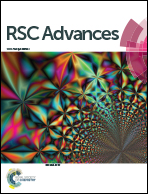HBT-based chemosensors for the detection of fluoride through deprotonation process: experimental and DFT studies†
Abstract
When searching to develop fluoride chemosensors based on O–H⋯F, we discovered that an HBT-based fluorophore containing a hydroxyl group was easily synthesized and displayed excellent fluorescence properties. 4-(benzothiazol-2-yl)-phenol (L1H) was found to facilitate the monitoring of fluoride and showed ratiometric fluorescence changes. It is worth noting that an aldehyde group in conjugation with the HBT-based fluorophore core at an adjacent position to the hydroxyl group (i.e. 5-(benzothiazol-2-yl)-2-hydroxybenzaldehyde, L2H) would elevate the sensitivity towards fluoride immensely. Spectroscopic studies indicated that L1H and L2H interacted with a fluoride anion, which involved a two-step reaction: hydrogen bond formation and deprotonation. Deprotonation of the chemosensors by a fluoride anion enhanced the electron-donating ability of the phenolic O− to the HBT core acceptor and facilitated an intramolecular charge transfer process, resulting in a red shift in both UV-vis absorption and fluorescence spectra. The mechanism of L2H binding with fluoride was confirmed by 1H NMR titration experiments and DFT computational calculations.


 Please wait while we load your content...
Please wait while we load your content...